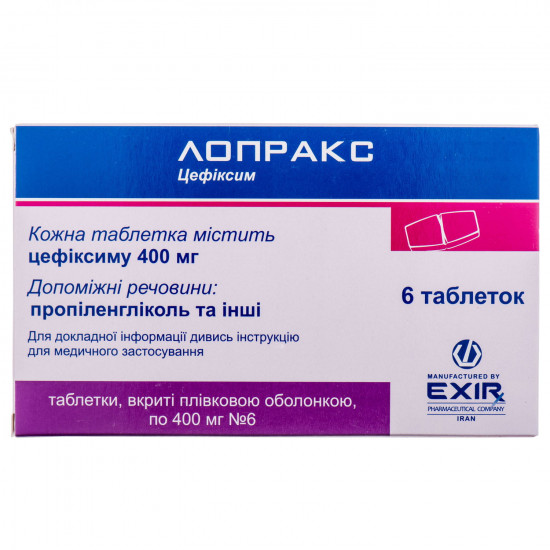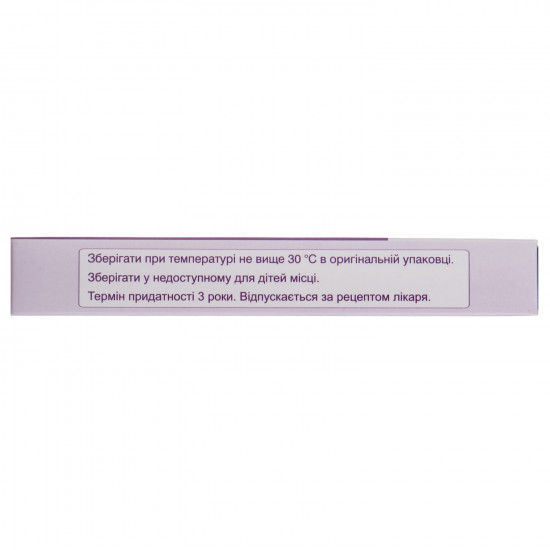



- Stock: In Stock
- Model: 181894
0% Customers recommend this product
-
5 Awesome0%
-
4 Great0%
-
3 Average0%
-
2 Bad0%
-
1 Poor0%
Reviews Over Lopraks tab. of p/o of 400 mg No. 6
- (0)
Total Reviews (0)
click here write review to add review for this product.
Report this review.
Description
Pharmacological properties
Pharmacodynamics
Tsefiksim — a tsefalosporinovy antibiotic of iii of generation with a wide range of antibacterial action. works bakteritsidno, breaking synthesis of a cell wall of microorganisms. tsefiksy interacts with penitsillinsvyazyvayushchy proteins in cytoplasm of a bacterial membrane and acylates transpeptidase enzymes within a membrane, breaking the cross bonds of peptide chains necessary for ensuring durability of a cell wall of bacteria. tsefiksy suppresses growth and division of bacterial cells and causes their lysis. are especially sensitive to a tsefiksim of a bacterium with a high speed of division.
Tsefiksim is resistantto action β-лактамаз (penicillinases and tsefalosporinaza), is active concerning a wide range of gram-negative microorganisms, including the strains producing penicillinase: N. gonorrhoeae, Citrobacter spp., Escherichia coli, Enterobacter spp., Klebsiella spp., Morganella, Proteus, Providencia spp. and Serratia species.
gram-positive cocci are sensitiveTo a tsefiksim: Streptococcus pyogenes, S. pneumoniae; all gram-negative microorganisms, including strains: H. influenzae, M. catarrhalis and N. gonorrhoeae producing β-lactamazu.
are Moderately sensitiveto a tsefiksim of a bacterium of the sort Staphylococcus. Sort Pseudomonas bacteria are resistant to a tsefiksim.
Pharmacokinetics
Tablet. It is quickly soaked up in a GIT. Bioavailability — 40–50%. The maximum concentration in blood serum is reached in 4 h (at inclusion in meal time — on 0.8 h earlier). 65% contact proteins of blood plasma (generally with albumine). T ½ makes 3–4 h. At patients with a renal failure at clearance of creatinine of 20-40 ml/min. of T ½ increases to 6.4 h, at clearance of creatinine of 5-10 ml/min. — to 11.5 h. It is allocated mainly with urine (50%) in not changed look during 24 h and with bile (10%).
Suspension. At intake about 60% of medicament are absorbed. T ½ makes 2.5-3.8 h of blood plasma (on average 3 h). Distribution volume — 0.1 l/kg. Linking with proteins of blood plasma — 70%.
Indication
Tablet: the infections caused by microorganisms, sensitive to drug: acute and chronic bronchitis, pneumonia, otitis, pharyngitis, tonsillitis, sinusitis, infections of an urinogenital system.
Suspension: the infections caused by microorganisms, sensitive to drug: acute and chronic bronchitis, otitis, pharyngitis, tonsillitis, infections of an urinogenital system.
Use
Tablet: inside to adults and children 12 years and with a body weight of 50 kg irrespective of meal are aged more senior. the usual dose makes 400 mg/days a course of treatment — from 3 days (treatment of uncomplicated cystitis) to 10–14 days.
In an uncomplicated gonococcal urethritis or a cervicitis are appointed by 400 mg once. It is not required from patients of advanced age of dose adjustment.
At patients with impaired renal function (clearance of creatine of 20 ml/min.) the daily dose should not exceed 200 mg.
less than 400 mg of Lopraks applyIn need of a medicament dosage in the form of suspension.
Suspension: intended for use in pediatric practice. A usual daily dose at children aged from 6 months up to 12 years with the body weight of 50 kg — 8 mg/kg of body weight of the child of 1 times a day. In a dose of 4 mg/kg of body weight — 2 times a day (each 12 h). Duration of a course of treatment — from 3 days (uncomplicated infections) to 10–14 days, depends on disease severity and is established individually.
to Children with the body weight of 50 kg or 12 years are aged more senior thanappoint medicament in the doses recommended for adults: on 400 mg of 1 times a day or on 200 mg 2 times a day (each 12 h).
For preparation of suspension use the svezhekipyachenny and cooled to room temperature water. The bottle is opened and add water (about ½ volumes of a bottle), closed a cover and carefully stirred up. After that add water to the level of a mark in a bottle, close a cover and again stir up. Before each reception ready suspension needs to be stirred up carefully. To accept inside to or after meal; at irritation of a GIT — at meal time.
Contraindication
Tablet: hypersensitivity to antibiotics of group of cephalosporins, oh, a renal failure, the period of pregnancy and feeding by a breast, children aged up to 12 years.
Suspension: hypersensitivity to antibiotics of group of cephalosporins, OH, a renal failure, the period of pregnancy and feeding by a breast, children aged up to 6 months
Side effects
Insignificant also develop seldom.
from central nervous system: headache, dizziness.
from the system of blood and the vascular system: eosinophilia, leukopenia, thrombocytopenia, neutropenia, hemolytic anemia, prothrombinopenia, thrombophlebitis.
from a GIT: enterospasms, diarrhea, nausea, vomiting, candidiasis of a mucous membrane of an oral cavity; pseudomembranous colitis (spasms and stomach and intestines pain, bloody diarrhea, fever).
from a gepatobiliarny system: ikterichnost of scleras or skin.
from an urinary system: interstitial nephrite.
from the immune system: allergic reactions — rash on skin, an itching, urticaria, an anaphylaxis, a multiformny erythema or Stephens's syndrome — Johnson, a serum disease.
from a reproductive system: vaginal candidiasis (vaginal itching or discharges).
General disturbances: fast fatigue, weakness.
from laboratory indicators: tranzitorny increase in level of transaminases of a liver, increase in level of nitrogen, urea or creatinine in blood serum.
Special instructions
before therapy lopraksy needs to exclude existence at the patient of hypersensitivity to antibiotics of group of cephalosporins or penicillin (cross allergic reactions are possible). at development of allergic reaction on tsefiksy medicament should be cancelled immediately.
With care is appointed to patients in the presence of allergic reactions (especially to medicines), to patients with bleeding in the anamnesis, to patients with gastrointestinal diseases (especially with nonspecific ulcer colitis, regional colitis or enteritis (Crohn's disease)), in an abnormal liver function.
Prolonged use of medicament can leadto development of dysbacteriosis and cause the strengthened growth of Candida albicans (candidiasis of a mucous membrane of an oral cavity); development of heavy diarrhea and pseudomembranous colitis is possible. At use of a tsefiksim the development of a vitamin deficiency of group B is possible. During medicament treatment can note pseudo-positive takes of glyukozurichesky tests and positive forward reaction of Koombs.
Tsefalosporinovy antibiotics increase toxicity of alcohol, during treatment the consumption of alcoholic drinks is not recommended.
Suspension: to children with a disease of kidneys appoint medicament in a dose of 1.5-3 mg/kg of body weight a day.
In the diseases caused by a β-hemolytic streptococcus of group A, the course of treatment has to make not less than 10 days for the purpose of prevention of development of acute rheumatic fever or a glomerulonephritis.
control of laboratory indicators of blood and also function of a liver and kidneys is necessary forAt long-term treatment.
Period of pregnancy and feeding by a breast. Lopraks gets through a gematoplatsentarny barrier. There are no data on safe use of medicament during pregnancy; during this period medicament is not appointed. For the period of treatment it is necessary to stop breastfeeding.
Children. Tablets: appoint to children aged 12 years are more senior.
Suspension: there are no data on safe use of medicament for children aged 6 months
Influence on ability to run vehicles or to work with other mechanisms are younger. Does not influence, however it is necessary to consider possible side reactions from central nervous system (individually in each case).
At a concomitant use of a lopraks and nephrotoxic medicaments (diuretics) the increase in nephrotoxic effect, especially at patients with a renal failure is possible
Interaction.
At a concomitant use with aminoglycosides needs to control function of kidneys.
Combined use of a tsefiksim and carbamazepine increases concentration of carbamazepine in blood serum.
Overdose
Symptoms: dizziness, nausea, vomiting.
Treatment: gastric lavage, symptomatic therapy. The hemodialysis or peritoneal dialysis are ineffective.
Storage conditions
At a temperature not above 25 °C.
Specifications
| Characteristics | |
| Active ingredients | Tsefiksim |
| Amount of active ingredient | 400 mg |
| Applicant | Exir |
| Code of automatic telephone exchange | Tsefiksy J01DD08 |
| Interaction with food | It doesn't matter |
| Light sensitivity | Not sensitive |
| Market status | The branded generic |
| Origin | Chemical |
| Prescription status | According to the prescription |
| Primary packing | blister |
| Producer | EKSIR PHARMACEUTICAL COMPANY |
| Quantity in packing | 6 tablets |
| Release form | tablets for internal use |
| Route of administration | Oral |
| Sign | Import |
| Storage temperature | from 15 °C to 25 °C |
| Trade name | Lopraks |



















































